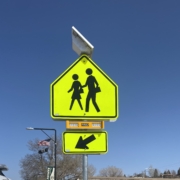The Importance of Versatility and Standardization in RRFBs
Have you heard about the importance of versatility and standardization in RRFBs?
In today’s blog, the Availed Technologies team outline why this is so crucial, its many benefits, and a real-life example of versatility and standardization done right.
Let’s dive in.
What Are RRFBs?
RRFBs are a unique traffic control device designed specifically to improve pedestrian safety at uncontrolled marked crosswalks. Uncontrolled crosswalks come in many different shapes and sizes from one-way or two-way roadways, from two to four lanes, and with or without median islands, curb bulb outs or extensions, etc.
On the other hand, uncontrolled crosswalks can be located at intersections where the major legs are through lanes or at mid-block locations such as school crossings or trail crossings. Other locations include roundabouts and bicycle corridors.
Lastly, crosswalk locations can sometimes have sightline issues due to curves or other features.
What is Versatility and Standardization in RRFB-Related Product Design?
With over 25 years of combined experience in the Solar LED industry (and, more specifically, solar LED for traffic safety), our team has both the knowledge and the skillset to deliver products that out-perform the competition year after year.
How do we achieve this?
By utilizing both versatility and standardization.
Versatility refers to how adept a product is at being used in a range of configurations that stem from the crosswalk and roadway design.
Standardization in this discussion is defined as the extent to which versatility can be accomplished with a single model.
For example, a key requirement for configuring RRFBs at the crosswalk is to have lightbars visible to oncoming vehicles on both the left and right hand side of the roadway. This requirement, coupled with the wide range of crosswalk configurations results in the need for the RRFB device to be versatile. Consider these scenarios:
- Two way, two lane roadway. In this common configuration there are two back-to-back lightbars on each side of the crosswalk.
- Two way, four lane roadway with median. In this configuration there are typically single sided lightbar systems on the curb sides and either one back-to-back system or two single sided systems on the median. The systems on the median may or may not have push buttons.
- Crosswalks at a roundabout. In this application each crosswalk is for one-way traffic, therefore single sided lightbars are typically used.
As demonstrated here, RRFBs can include either one or two lightbars and be with or without a push button. In some cases, such as when sightlines require it, the location of the lightbars will be different than where the push button should be located. This scenario may utilize a system that consists of only the solar engine and the push button, without any lightbars.
In other cases, such as when RRFBs are installed in advance of the crosswalk with the Ahead sign, the system would consist of one lightbar and no push button.
In all cases with RRFBs, there is a wireless connection between systems so that when a push button is activated on one system the other system(s) at the crosswalk flash. Ideally the wireless connection between systems is automatic and requires no field configuration. Regardless of how many systems are used, all will turn on and off in a synchronized manner when the push button on any one of the systems is activated.
In the event that there are multiple crosswalks in proximity to one another there needs to be a means to avoid a push button actuation at one crosswalk activating lightbars at another crosswalk. This is referred to as crosstalk and can be easily addressed by a field adjustable dial on the solar engine controller for channel selection.
Learn More About Versatility and Standardization for RRFBs Today
The MUTCD 11th Edition, chapter 4L requires that RRFBs be on both the left-hand and right-hand side of the roadway for each approach. This frames the crosswalk for drivers and is one of the reasons the system is so effective. As we have seen, it does demand versatility in the system to allow for a range of installation configurations.
To simplify the ordering, inventory, and installation logistics an RRFB system should be able to have two, one, or no lightbars and either be connected to a push button or not. In other words, it should be both standardized and versatile.
At Availed Technologies, all of our products are created and sold with both versatility and standardization in mind.
By prioritizing these two product design factors, we ensure that our RRFBs fit a wide range of crosswalk configurations and are easy and fast to install.
To learn more about how to utilize our best-in-class RRFBs, or if you have questions about how to implement RRFBs in your particular situation contact our team today.

